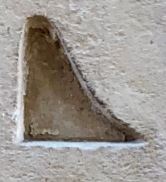| Token | Source | Date |

|

srq.t
Serket
|
4th century BC
|

|

ḥr.t ṯꜣz bqs.w nḥb.w-kꜣ.w
the one who is upon the knot of the spine of Nehebkau
|
Unas
|

|

gm ppy pn qbḥ.wt sꜣ.t jnpw
this Pepi will find qbH.wt, daughter of Anubis,
|
Pepi I Merire
|

|

sw.t nḥb-kꜣ.w ꜥšꜣ qꜣb.w pp.y p(w) sš nṯr mḏꜣ.t ḏd n.tt sḫpr jw.tt
He is Nehebkau, many of windings. Pepi is the gods scribe of the book, who says what is and who creates what is not.
|
Pepi I Merire
|

|

nj ḫbss n=f tꜣ nj sqr n=f wdn.t
The land can not be hacked for him, the wdn.t-offering cannot be presented to him.
|
Pepi II Neferkare
|

|

wsir ꜣḫ.t jqr.t n rꜥ (šr)j-rꜥ
Osiris, the efficient spirit of Ra, (Sher)ira.
|
Ramesside Period
|

|

ḏ=(j) t' n ḥqr ḥbs.w n ḥꜣ.y
I gave bread to the hungry and clothes to the naked.
|
1st Intermediate Period
|

|

pꜣ.tyw šꜣꜥ.w m jr.t jdb ḥq.t
The primeaval ones, who started making the riverbank of Heqat
|
Senwosret I Kheperkare
|

|

dj hq.t ḥnꜥ ẖnm.w
which Heqet and Khnoum gave,
|
Senwosret I Kheperkare
|

|

jqr ḥw.t-ḥr jwn.t nb.t jq
The nome of the Crocodile. Hathor of Dendera, the lady of the nome of the crocodile.
|
Senwosret I Kheperkare
|

|

n jsq=j z m mẖn.t
I did not hinder a man in the bark.
|
Senwosret I Kheperkare
|

|

sꜣq.n=f tꜣ pn rdj.n n=f rꜥ
He has gathered this land which Re has given to him.
|
Amenemhat II Nebukaure
|

|

ḥrw-r bꜣk snṯr ꜥd bj.t
apart from moringa-oil, incense, fat, honey
|
Kamose
|

|

sqꜣ ptḥ
Exalt Ptah
|
Ramesses II Usermaatre-Setepenre
|

|

štw šꜥd t-ḥnq.t m dbdb
The turtle is cut down, bread and beer as pieces
|
Cleopatra VII Philopator
|

|

n srq(.t) ḥr(y)-jb bḥd.t
for the scorpion, residing in Edfu
|
Cleopatra VII Philopator
|

|

twt sꜣ wr prj m qꜣy.t nḥb-kꜣw grg tꜣ pn
You are the eldest son, who went forth from the high field, Nehebkau who established this land.
|
Cleopatra VII Philopator
|

|

wnn skr sꜣq m ḏ.t=f ḥqꜣ.t ḥnw wṯs ḥm=f m tꜣ
Sokar is gathered in his body, she who rules the Henu-bark, who lifts his majesty in the land.
|
Cleopatra VII Philopator
|

|

sꜣ-tꜣ ṯḥn.t ḥr m nb.w-q-ꜣbd
Sata, faienced of face in nb.w-q-Abd
|
Cleopatra VII Philopator
|

|

msnt.y qn ḥr smꜣ ḥnt.yw ḫfꜥ ḫmt r ḫt ḫnt
The brave harpooner is killing the crocodiles and grabbing the harpoon in order to repel the crocodile.
|
Cleopatra VII Philopator
|